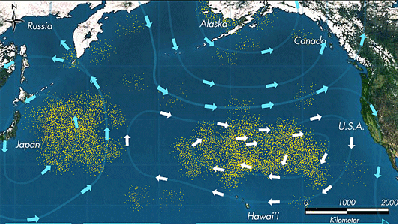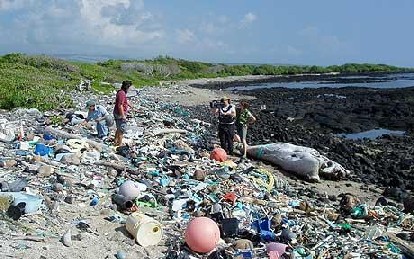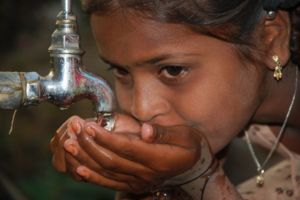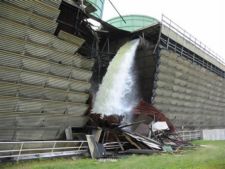Captain Charles Moore on the “plastic soup” engulfing the world’s oceans and how plastic harms the human body
Tuesday, May 19th, 2009Listen Now Download the show by right-clicking the link.
How can we halt the pollution of our oceans with plastic garbage? And how can we stop the production of plastics which are contaminating not only the seas but also our bodies? In this fascinating episode, Dr. Caldicott speaks with Captain Charles Moore, who founded the Algalita Marine Research Foundation in 1994. In 1995, Moore launched his purpose-designed, aluminum-hulled research vessel, Alguita, in Hobart, Tasmania. On his return voyage from a yacht race in 1997, Moore veered from the usual sea route and saw an ocean he had never known. “There were shampoo caps and soap bottles and plastic bags and fishing floats as far as I could see. Here I was in the middle of the ocean, and there was nowhere I could go to avoid the plastic.” Ever since discovering this enormous plastic oceanic gyre the size of Africa, the Great Pacific Garbage Patch, Moore has dedicated his time and resources to understanding and remediating the ocean’s plastic load. This program addresses the enormous problem of plastic in the ocean, and also expands on the issue of how chemicals used to make plastic are damaging the human body, a topic first discussed in our recent program with Dr. Maricel Maffini. Have a look at this in-depth color graphic describing the garbage patch. And see this excellent color transparency about how the plastic gyre is created.
Capt. Moore, an ocean researcher, sea captain, racing sailor and surfer, describes how the floating plastic debris is damaging and killing many life forms, and is now found on one-quarter of the planet’s surface area, a total of 10 million square miles of ocean plastic litter. Moore has written about plastic particulate pollution for scientific journals and has developed protocols for monitoring beach and plastic pollution. See his articles A Comparison of Plastic and Plankton in the North Pacific Central Gyre and A Comparison of Neustonic Plastic and Zooplankton Abundance in Southern California’s Coastal Waters.

Great Pacific Garbage Patch (eastern and western gyres)
After Moore tells how he first came upon the vortex, he talks about how the ocean circulates the plastic trash, which now covers 10 million square miles. See this graphic of the approximate location of the trash vortex, and how deep underwater the trash goes. In 2006, the UN Environment Program figured that each square mile of ocean includes 46,000 pieces of floating plastic. Moore stated in another interview that “Except for the small amount that’s been incinerated – and it’s a very small amount – every bit of plastic ever made still exists.” See this chart showing how plastic production is growing at alarming rates. In this program, you will learn how plastic in the ocean never disappears, and that even when it breaks down into tiny particles, it is still extremely destructive. Moore describes how fish, birds and other marine life are killed by the plastic debris.
Moore informs Dr. Caldicott where the litter originates on land. He describes how sea traffic is increasing by leaps and bounds, increasing the stress on the oceans. Globalization, competition and consumerism are vastly and exponentially increasing the amount of plastic worldwide. Dr. Caldicott asks Moore about the carbon footprint of ships. See the press release EPA Urged to Reduce Global Warming Pollution from Ships and read Oceana’s report Shipping Impacts on Climate: A Source with Solutions. Capt. Moore talks about the unenforced treaty to halt marine pollution, and the outlook for the future of the oceans. No subsequent generation will swim in the ocean without encountering plastic, Moore says.
Moore mentions how plastic absorbs huge quantities of other oil-based chemicals. He describes the plastic pellets called nurdles which absorb up to 1,000,000 times their weight in pollutants, attracting chemicals such as DDT and hydrocarbons, and becoming part of the food chain. Moore refers to the work of Dr. Hideshige Takada of Tokyo University, author of the study Plastic Resin Pellets as a Transport Medium of Toxic Chemicals in the Marine Environment. Takada is now mapping the location of beached plastic pellets from oceans around the world through his group International Pellet Watch. See the diagram of how plastic pellets are transported and ingested by sea creatures. Moore describes how a plastic spill in the ocean is far more catastrophic than an oil spill. See Plastics ‘poisoning world’s seas’.
Moore refers to the book Cradle to Cradle by William McDonough and Michael Braungart, and says we have to rethink how everything is designed if we are ever to stop damaging our planet with toxic chemicals and disposable products. Dr. Caldicott says that as with nuclear waste, the only sane solution to the plastic problem is to stop making it. Recycling is not a viable solution. Read Plastics: Your Formidable Enemy - Questioning exposure, recycling, biodegradability, alternatives which also talks about ocean plastic and the human health aspects of plastic.
This program does not explore whether efforts should be made to remove and recycle the ocean plastic, and whether such capture-and-recycling efforts would further harm ocean life. To read more about the pros and cons of the recycling idea, see the articles Feds want to survey, possibly clean up vast garbage pit in Pacific and Mission to Break up Pacific Island of Rubbish Twice the Size of Texas and So we’ve got this trash-filled gyre, right? Can we fix it? and Media Catches the Boat to Pacific Garbage Patch and Ocean garbage mess and possible solutions and Can’t we just scoop up the trash? Eliminating the use of plastic bags can definitely reduce the ocean plastic problem. Read about one determined anti-plastic activist in A Woman, a Village and a War on Plastic Bags.
Why do people litter? Eighty percent of the ocean plastic originates on land (some of which occurs when nurdle pellets are spilled off trucks, but much of the trash starts with individuals littering). Read a U.S. study of littering behavior in Southern states and an Australian study about how to prevent littering. Also see this Litter Facts page.
Later in the show, Dr. Caldicott and Capt. Moore talk about phthalates, bisphenol-A and other toxic components in plastic, and how these chemicals are damaging human health from the womb to old age, disrupting hormone function and causing disease. See a handy table of plastics and their health effects, and visit the website Our Stolen Future for the latest on endocrine disruption research.
Moore describes how plastic is not inert, and releases chemicals at every stage. Moore mentions the work of Dr. Frederick vom Saal who contends that bisphenol-A is responsible for the epidemic of diabetes and obesity. See Diabetes and Obesity are Related to Plastics in Food and Beverage Containers. Also see An extensive new literature concerning low-dose effects of bisphenol A shows the need for a new risk assessment.
Americans go through 5 million disposable polyethylene bottles a day, Moore notes. Read the May 25 article Elevated BPA levels in people drinking out of plastic bottles, study finds which describes a 70% increase in bisphenol-A in urine among those drinking from plastic bottles. Read the study here. Moore says that Americans now have 100 -200 chemicals in their body – a large “body burden” of toxins that were unknown to science before the 1950’s. He says we have a huge challenge ahead of us to rid ourselves of these contaminants, especially when faced with a “growth economy.” Bioplastics (from corn, soy, potato, etc.) present their own problems as described in Rejecting the toxic plague: War on plastic.
In the oceans, Moore says, the ratio of plastic to plankton is increasing, and now averages a whopping 46 to 1. The plastic debris is creating oceanic deserts with very little plankton, and plankton is also being reduced by global warming. Plankton is the building block of all ocean life. See Decline in oceans’ phytoplankton alarms scientists: Experts pondering whether reduction of marine plant life is linked to warming of the seas and Warmer Seas Will Wipe Out Plankton, Source of Ocean Life.
For more on the big picture on the world’s oceans, read Altered Oceans, a five-part Los Angeles Times series which includes the article, Plague of Plastic Chokes the Seas. To learn about the threat of overfishing, see the report Hungry Oceans: What Happens When the Prey is Gone?. Also read about the study, Ocean acidification impairs olfactory discrimination and homing ability of a marine fish and the report Ocean acidification due to increasing atmospheric carbon dioxide. And read the article Anthropogenic carbon and ocean pH: The coming centuries may see more ocean acidification than the past 300 million years. And visit the Web site of the Ocean Acidification Network. Climate change is also bringing a jellyfish plague. Read Beautiful, but Deadly: Jellyfish Blooms Appear to be on the Rise. Is Global Warming Causing an Ocean Swarming?.

Kamilo Beach, Hawaii, with more beached plastic particles than sand (Algalita Marine)
For more on the problem of ocean plastic, see the Greenpeace report Plastic Debris in the World’s Oceans and the new Sierra magazine article Message in a Bottle. Also read Our Oceans Are Turning Into Plastic…Are We? and Why plastic is the scourge of sea life and The world’s rubbish dump: a garbage tip that stretches from Hawaii to Japan. Visit Greenpeace’s Disposal Oceans? page. Watch videos about ocean plastic on the Plastic Soup website. For more about the work of Captain Charles Moore, read Conversation: Captain Charles Moore Talks Trash and Plastic Soup: Where Trash Lives Forever. Watch Moore’s 7-minute presentation at the 2009 TED (Technology, Entertainment, Design) conference, “Capt. Charles Moore on the seas of plastic.”
As Dr. Caldicott states on this episode, we must become scientifically literate to lead the planet toward survival. Be sure to listen to this program to inform yourself.







